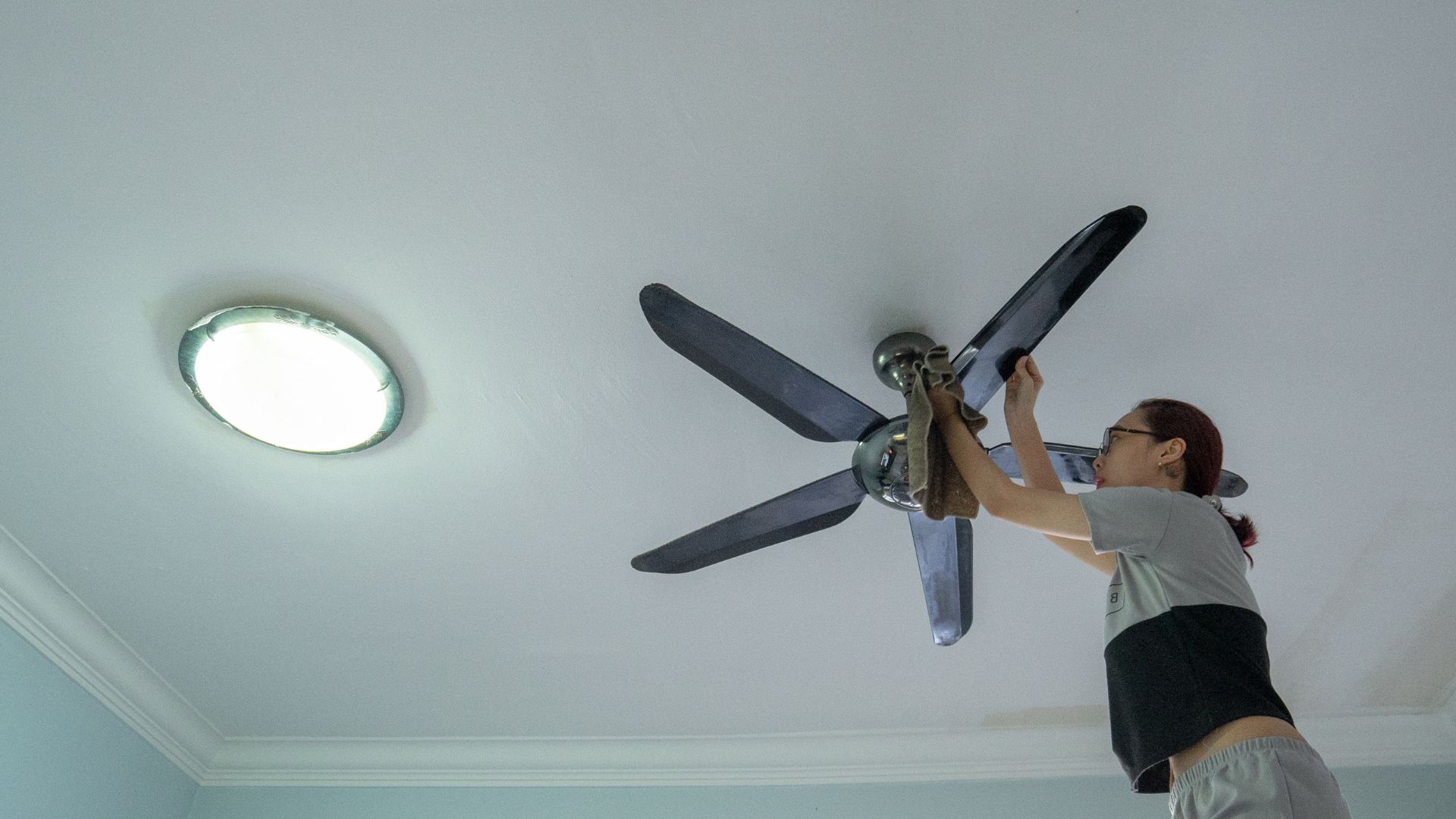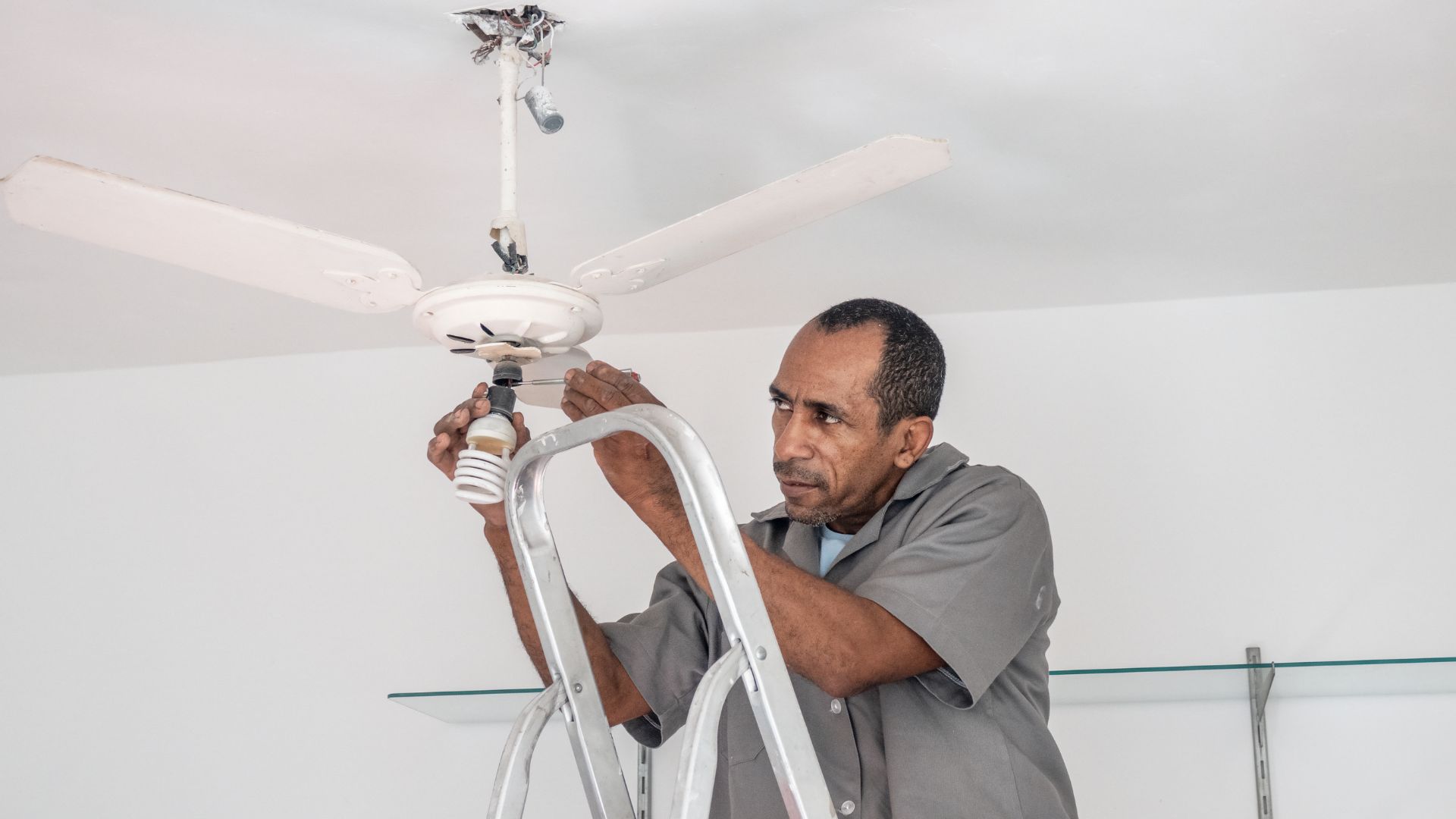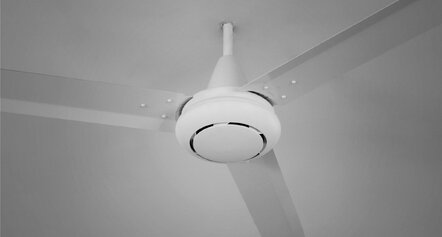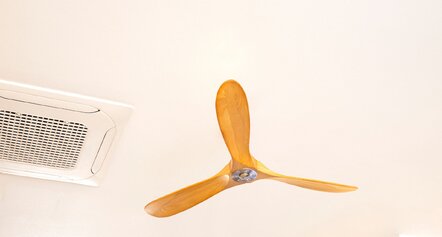Ceiling fans are a staple in many Australian homes. They offer a cost-effective way to stay cool during the warmer months and circulate warm air in cooler seasons. Regular cleaning and maintenance are essential to ensure your ceiling fan operates efficiently and has a long lifespan.
Neglecting this can lead to dust accumulation, decreased efficiency, and potential mechanical issues. This guide provides practical steps to keep your ceiling fan in optimal condition.
Let’s keep your ceiling fan spinning!
Why Regular Cleaning and Maintenance Matter

Over time, ceiling fans collect dust and debris on their blades and motor housing. This build-up can cause the fan to wobble, produce unusual noises, and operate inefficiently, leading to increased energy consumption and higher energy bills.
Regular cleaning enhances the fan’s performance and improves indoor air quality by preventing the circulation of dust and allergens.
Tools and Materials Needed
Before you begin, gather the following items:
- Microfiber cloths
- Mild dish soap
- Warm water
- Step ladder
- Vacuum cleaner with a brush attachment
- Screwdriver
- Compressed air
- Balancing kit (if needed)
Safety First
Safety is paramount when cleaning ceiling fans. Always turn off the fan and, if necessary, switch off the power at the switchboard. Ensure your step ladder is stable and positioned on a flat surface. If you’re sensitive to dust, consider wearing a mask to prevent inhalation of allergens.
How to Clean Ceiling Fan Blades
Dry Dusting Method: Use a microfiber cloth or a vacuum cleaner with a brush attachment to remove loose dust from the fan blades. Gently wipe or vacuum each blade, ensuring they don’t bend or warp. Regular dusting helps prevent dust build-up, which can lead to decreased efficiency.
Wet Cleaning for Heavy Buildup: Mix a few drops of mild dish soap with warm water for stubborn grime or grease, especially in kitchens. Dampen a microfiber cloth in the solution and gently wipe each blade. Avoid soaking the blades, as excessive moisture can damage the finish or cause warping.
Cleaning the Motor Housing and Light Fixtures
Motor Housing: Use a soft cloth to wipe down the motor housing, removing any dust or debris. For hard-to-reach areas, a can of compressed air can help dislodge dust from vents and crevices.
Light Fixtures: If your ceiling fan includes light fixtures, remove the light covers carefully. Wash them with a mild detergent and warm water, then dry thoroughly before reattaching. This ensures optimal illumination and prevents dust from dulling the light.
Ceiling Fan Maintenance Tips
Tighten Screws and Check Mounting Brackets
Periodically inspect and tighten all screws on the fan blades, motor housing, and mounting brackets. Loose screws can cause wobbling and noise during operation.
Lubricate the Motor
Some ceiling fans require periodic lubrication. Consult your fan’s manual to determine if this is necessary. If so, apply a few drops of the recommended lubricant to the motor housing to ensure smooth operation.
Balance Blades if Wobbling:
If your fan wobbles during operation, it may be unbalanced. To correct the imbalance, use a balancing kit, which typically includes adhesive weights. Follow the manufacturer’s instructions for the best results.
Check Remote and Speed Controls
Ensure that all controls are functioning correctly. Replace batteries in remote controls as needed and verify that the fan responds appropriately to speed adjustments.
How Often to Clean and Maintain
Cleaning Schedule: Aim to dust your ceiling fan blades at least once a month. Schedule a deep cleaning session every three to six months for a more thorough cleaning, including the motor housing and light fixtures.
Maintenance Check: Conduct a comprehensive maintenance check, including tightening screws and lubricating the motor, bi-annually or annually, depending on usage.
Signs Your Fan Needs Attention
- Excessive Noise: Unusual noises can indicate loose components or the need for lubrication.
- Wobbling: A wobbling fan suggests unbalanced blades or loose mounting brackets.
Reduced Airflow: If you notice a decrease in airflow, it may be due to dust build-up on the blades or motor issues
When to Call a Professional
While most homeowners can handle regular cleaning and minor maintenance, certain situations require professional assistance:
- Consult a licensed electrician if you suspect wiring problems or experience intermittent operation.
- Persistent noises or operational faults not resolved through basic maintenance may indicate deeper mechanical issues.
- Professional installation ensures safety and proper functionality if you’re considering upgrading components or installing new parts.
How To Maintain Ceiling Fans

Regular cleaning and maintenance of your ceiling fan are crucial for its efficiency, longevity, and the overall comfort of your home. By incorporating these simple steps into your household routine, you can enjoy ceiling fans all year long.
Are you having issues with your ceiling fans, need some help to maintain your ceiling fan or looking to install new ones? Speak with our Sunshine Coat electricians at Watt Edge Electrical today!
Frequently Asked Questions
What maintenance does a ceiling fan need?
Ceiling fan maintenance involves more than just cleaning. To keep your fan running smoothly, you’ll want to clean the fan blades regularly, check for loose screws, and inspect the motor casing.
Clean the motor housing and internal components using a soft-bristled brush or compressed air, especially in hard-to-reach areas. Gently wipe the light kit and use a vacuum cleaner with a brush attachment to remove dust.
Following the manufacturer’s instructions for routine maintenance ensures your fan stays in peak efficiency. A little regular upkeep goes a long way in improving energy efficiency and preventing costly repairs down the track.
Do I need to lubricate my ceiling fan?
Not all ceiling fans need lubrication, but some older or less modern fans may require it for smooth operation. If your fan starts making unusual noises or slows down unexpectedly, the issue might be with dried-out internal components. Add a few drops of appropriate oil to the motor housing (only if the fan is designed for lubrication—check the manual first).
Newer energy-efficient fans are typically sealed and maintenance-free in this regard. However, regularly cleaning your ceiling fan and checking all the screws can help prevent friction and extend your fan’s lifespan.
Do you need to service a ceiling fan?
Yes, servicing a ceiling fan is part of proper maintenance—especially if you want to reduce energy costs and improve air quality. Regularly cleaning the ceiling fan blades, motor casing, and light fixtures helps prevent dust build-up, which can strain the motor and lead to decreased efficiency.
If your fan has a pull chain, test if it’s working properly. If you’re experiencing persistent issues, need to replace electrical components, or notice a drop in performance, it’s a good idea to book a professional for ceiling fan upkeep. Routine servicing supports optimal condition and reduces heating costs over time.
What is the common problem of a ceiling fan?
The most common issues with ceiling fans include wobbling, decreased airflow, and strange noises—often caused by loose screws or unbalanced blade arms. Dust and dirt build-up on spinning blades and inside the motor housing can also lead to decreased efficiency and increased energy consumption.
If your fan is running slower or making more noise than usual, it might be time for a deep cleaning and a maintenance check. Using adhesive weights from a balancing kit or simply securing all the screws can usually fix minor problems before they escalate.




